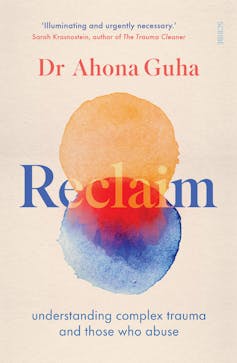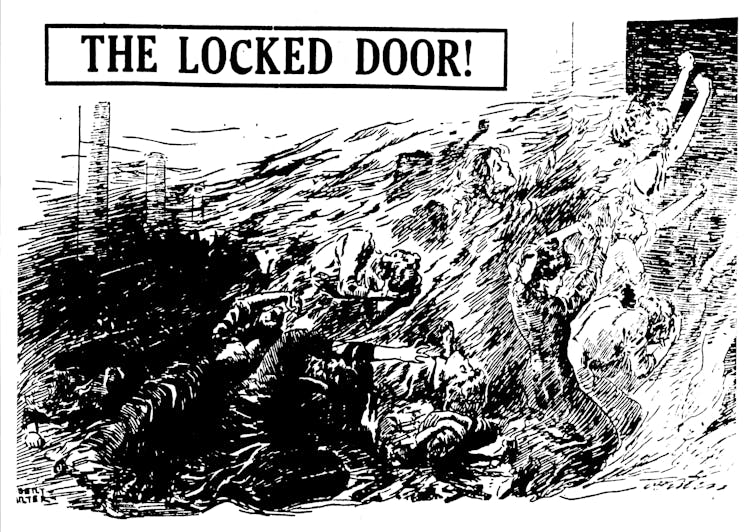Around the turn of the 20th century, Imperial Russia was a volatile place. Living conditions were harsh for most people, labour was exploitative and taxes were high. There were strikes and rebellions, and Jewish immigrants were restricted to an annexed region known as the Pale of the Settlement, where “pogroms” – antisemitic riots and mob persecutions – had long menaced.

Between 1903 and 1906, as the deadliest waves swept across 64 towns in the Settlement, a girl child named Rivka hid in an alcove with her family amid gunshots and broken windows; in 1907 her fate was decided. She was to leave for America, with her parents to follow (they never did make it).
Aged 14, Rivka became Rebecca, en route to New York by steamship. Magdalena Ball’s verse novel, Bobish (Yiddish for “grandmother”) charts her great-grandmother Rivka’s passage – and her life beyond.
Bobish is published by Puncher & Wattman, an indie publishing house doing more than its share to keep alive novellas, verse novels and other forms not considered commercially viable in Australia. The cover image shows a young woman with the thousand-yard stare of the trauma survivor.
Review: Bobish – Magdalena Ball (Puncher & Wattman) and Reclaim – Ahona Guha (Scribe)
Complex trauma
For many with complex trauma histories, leaving home young is less a choice than a necessity or compulsion. When the pain of a situation – social or familial – outweighs the need for family bonding and the security of community, you Get Out.
I was 15, a year older than Rivka, when I fled: not from persecution, but from the powerlessness of a childhood in a family fractured by divorce and the stream of abusive men ushered into my mother’s life.
Complex relational trauma is broadly defined as cumulative and multiple traumatic events featuring interpersonal threat.
For some, this legacy amounts to an unrecognised, unaccommodated disability. Many work overtime to keep a raging chronic fight or flight response dampened down to a degree of functional equilibrium, in societal conditions that continually trigger it.
Early starters like Rivka (or, Rebecca) are confronted with the dilemmas and dramas of the adult world before the neocortex has developed enough to comprehend them, and with a traumatised amygdala and hippocampus firing on all cylinders.
Ball writes beautifully of Rebecca’s departure, voyage and beginnings in the Bronx, evoking this complicated soup of experience with a nod to childlike wonder, in poems like Ocean Mandela:
Her eyes became a kaleidoscope spiralling with the water refracted
through tears she kept from falling …
The poem ends with a description of the haunting past she leaves behind:
memory was Prussian Blue a cyanotype carried like ghostly love.
Bobish is transgenerational literary trauma testimony, which, as I argued in my monograph, The Poetics of Transgenerational Trauma, amounts to a kind of intuitive-affective translation that “comes with its own linguistic and creative reading of the experience of others”.
Read more: Complex trauma: how abuse and neglect can have life-long effects
Reclaim and 21st-century trends
Reading Ball’s verse, woven with strands of nonfiction, family lore, and affective imagination, alongside Reclaim: Understanding complex trauma and those who abuse by Dr Ahona Guha, it is as if Ball and Guha’s projects were born to intertwine.

Guha, a clinical psychologist and forensic expert, has penned a book about trauma that is not literary, academic, or self-help: it is a clear-eyed analysis by a professionally qualified, socially engaged and intimately informed author. Guha purportedly wrote the book to redress fallacies in “a world that is beset by trauma.”
This points to a perplexing paradox. As Guha underscores, trauma is trending – at least on the socials. We’ve come a long way since Charles Myers used the term “shell shock” to describe the shattered men returning from the trenches in 1915, and Freud defined trauma as “any excitations from the outside which are powerful enough to break through the protective shield”, thus flooding and binding the psyche (neuroscience has since confirmed traumatic injury as a re-wiring of the brain). As Guha says, this complicated process “will never be adequately captured by a TikTok video or an Instagram reel”.
While increased awareness of trauma is welcome, it comes with a downside. Guha observes that Western society’s tendency to medicalise and pathologise experience leads to difficult feelings and situations being defined as traumatic when they may well not be.
She states, “the reach of technology and social media has facilitated access to easy and overly simplistic information about complex mental health phenomena”, frequently circulated by “people who have limited or no formal qualifications in health or mental health”.
This may sound like a shot at grassroots knowledge, but it’s fairer to call it a level-headed acknowledgement that diagnostic terms (such as narcissist and psychopath) are being overused as buzzwords. And that some who stand to profit use mental health and trauma terminology for unscrupulous purposes, such as the peddling of personal growth thirst traps.
Guha discloses her own history of complex trauma to challenge the shame and disparaging associations that stick to trauma. I’ve been open about my history of complex trauma for much the same reason.
Symptoms celebrated and stigmatised
While some symptoms of complex trauma, such as workaholism and fawning (otherwise known as people pleasing) are culturally embraced and rewarded, others, such as addiction to illegal substances, are denounced and criminalised.
Many in the prison system suffer from complex trauma, as Guha highlights.
In a recent study, researchers at the UNSW Centre for Social Research in Health confirmed systemic discrimination toward prisoners with histories of injecting drug use (up to 58% of the prison population) upon release from prison. (I was commissioned to write a creative work based on interview transcripts and performed by a community member to help communicate these findings to stakeholders and the public).

It’s worth noting that according to the Australian Bureau of Statistics, Aboriginal and Torres Strait Islanders in New South Wales are incarcerated at almost ten times the rate of non-Indigenous Australians.
Some people in high places hope their past addiction never comes to light: public servants, medical professionals, and others whose careers would be at stake if outed. This bigotry is a hypocritical outrage. Assuming a certain baseline of recovery, why should people with histories of injecting drug use be viewed as anything but an invaluable workplace resource with a wealth of lived experience?
There are also high-functioning drug users and heavy drinkers who perform well at work, though acceptability depends on the context. For example, you wouldn’t want to be operated on by a hungover surgeon, or travel on a bus with a stoned driver.
Despite Guha’s reasonable reservations about persistent shortfalls in nuanced understanding of trauma, our society’s heightened focus on trauma does hold promise. The environment Rivka escaped, beset by antisemitic attacks and pre-revolution tensions, and the world she entered when she docked – colonised Lenape land teeming with displaced people; disease ran rife in the ghettos and the homicide rate was high – were hotbeds of trauma transmission. These populations were almost entirely uneducated about trauma’s pernicious potential – and mostly unaided.
People with early complex trauma histories are among the most spectacular innovators and successes across a range of industries, propelled into prominence or power by a fierce internal drive.
But many childhood and adolescent complex trauma survivors are slow achievers. We grow into our talents and abilities – assuming we survive long enough – after navigating obstacle courses of linked conditions, including depression, anxiety disorders and other chronic illnesses.
We rise in our fields after spending years learning the basic life skills and coping strategies less traumatised people take for granted. Some are considered low achievers, spending a lifetime keeping their heads above water in oceans of emotional pain that would drown many of those who deem them inferior.
A reclamation
Bobish commemorates a life that was both remarkable and unremarkable. It proclaims the worth of those who may appear on the surface to be low achievers, but whose continued existence in the face of adversity is itself an affirmation of spirit over trauma.
Ball’s rendering of Rebecca’s trials is never melodramatic, even when “Beckie” is denied dignity through indifference or hostility. For example, in Guide to the United States for the Jewish Immigrant, Ball is even-toned:
A physician and a nurse
are in attendance.
(Illness is forbidden
if you’re marked as sick
you will be sent back.)

The verse novel, as a form, is always an interesting choice – and it is the perfect vehicle for memorialising Rebecca. While it’s not known for bestseller sales, it makes a vital contribution. Notable outings include Dorothy Porter’s renowned Monkey’s Mask and Seahorse by San-Francisco-based Australian poet, Natasha Dennerstein, about transitioning during the 1980s, which reads like a verse novella. (Dennerstein’s About A Girl is overtly marketed as a “novella in verse”.)
The beauty of the verse novel (or verse novella) is that it can tell a story without being constrained by prose’s demands for filled-in gaps and transitions between events. Good verse leaps over temporal gaps; the reader is released from the expectation of a blow-by-blow account, free to enter and inhabit the communicative space between poems as part of the narrative rhythm.
Rebecca’s New York trajectory unfolds like a case study of the traumatic operations Guha maps in Reclaim. She gets a job at the infamous anti-unionist Triangle Shirtwaist Factory, where bosses lock in the garment workers, to maximise productivity and prevent theft. (Miraculously, Rebecca is not at work the day of the fire that kills 146 people.)

She meets a charming fish smoker who speaks 11 languages. A fellow Jewish immigrant and one-time scholar studying to become a Rabbi, he is relegated to working a pushcart downtown near the tenements. They soon wed.
Guha introduces shorthand to better understand trauma. “Big T” stands for life-threatening trauma; “little t” is for subtler forms of trauma that “often go unrecognised by victims or people around them”. The tangled spectre of both infuses Rebecca’s marriage.
Guha foregrounds “relational trauma” – trauma that occurs in a relational context – noting that childhood relational trauma typically shapes “someone’s entire identity and the way they think and feel”. This oozes from the page in Ball’s depictions of Rebecca.
Guha unpacks “trauma responses” (such as fight-flight-freeze-tend-befriend defences) as the primary mechanisms for managing traumatic tension. The fish smoker is stuck in fight mode and turns out to be a violent, alcoholic presence in the home.
Ball holds him accountable, but handles him with compassion. In Pickled Herring Pushcart, Ball imagines walking “backwards into the tableau” to sit with him “in some crack between our worlds where we could speak freely”. She imagines him taking her hands to:
Whisper everything
so I might understand
contrition and trauma
in equal measure.
And in La Grippe, she tells her ailing great-grandfather, nursed by Rebecca:
Ach, fish smoker. You cannot change the past.
It wends its way through the funhouse of time in antigenic drift and shift,
viral particles, infecting the future.
Read more: 3 trauma takes the media gets wrong
Hurt people hurt people
Here, the two texts intersect poignantly. The most admirable thing about Guha’s admirable book is its advocacy for those caught in the darkest realms of trauma’s slipstream: the least likeable among us, who act out in the most socially unacceptable ways. Guha demands we seek to understand not only traumatised sweethearts (those who invite sympathy) but also people who exhibit alienating, infuriating or frightening trauma-fuelled traits.
Trauma denied and/or unconscious gives life to the adage “hurt people hurt people”. Disengaged from the vulnerable roots of their suffering and in a state of unrelenting reaction, traumatised people can become traumatisers. Guha clarifies, though, that “harmful behaviour arises from a confluence of factors” and trauma alone does not explain abuse.
The fish smoker was not a monster. My mother’s partners were not monsters. They were damaged and socially conditioned men who damaged other people. A history of complex trauma doesn’t excuse violations, but it is frequently at the core of them – and we ignore that at our peril. “We have neat binaries in our minds: victims and perpetrators,” states Guha. In some cases, that neatness belies a chaotic crossover.
It feels like feminist sacrilege to say this, such is the attachment to the binary. Guha’s willingness to confront this murky terrain is courageous, and the risky nature of the move might be why Guha features several women in the chapters focused on harmful behaviour.

Trauma as a political tool
Guha’s appeal is crucial, because the failure to grasp the trauma behind many crimes gives rise to dehumanisation and yet more trauma – sometimes in the form of state violence, such as Aboriginal deaths in custody and the Northern Territory Emergency Response, otherwise known as “The Intervention”.
Guha’s chapter on “The Politics of Trauma” is an important contribution. Guha is unusual among psychology-trained authors in taking a firm political stance around “reducing reliance on policing and incarceration-based responses” and advocating for an “equitable trauma-informed society”.
“We fail trauma victims when we do not identify them, and when we do not provide appropriate care”, she says. (For example, the federally funded mental health plan is inadequate for complex trauma, and the 20 subsidised sessions per year permitted during COVID lockdowns were scaled back to ten in 2022.)
But there are worse things than being ignored. Too often, leaders actively enable structural disadvantage and are responsible for gross failures of governance that themselves prove traumatising, as was the case with the disreputable Robodebt Scheme. The true measure of its malice has come to light via the Royal Commission, which Rick Morton has covered exhaustively in The Saturday Paper and The Monthly.
The driving force of Bobish is Ball’s veneration for Rebecca, and while the subtle characterisation of her great-grandfather is commendable, she does not shy away from the pain he caused Rebecca and the family. Ultimately, Ball has crafted these poems – in consultation with relatives and her aunt’s memoir and diaries – to honour her bobish.
Rebecca faced continual hardship and died relatively young in part because trauma took its toll on her health. But Ball also shows her loving and laughing, reanimated in scenes of family merriment and tenderness.
Both Bobish and Reclaim push back against common value judgements that less traumatised – and more privileged – people make about those living with complex trauma.
One by looking back; the other by looking around soberly – and inviting us to build a “trauma-informed community” and move toward a more just future.

